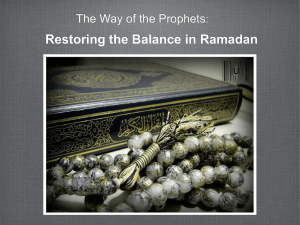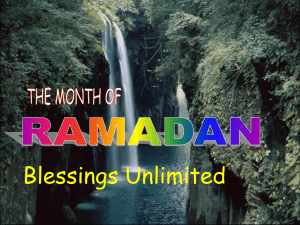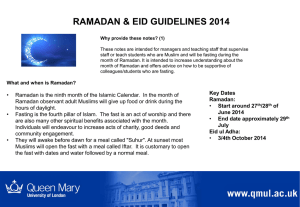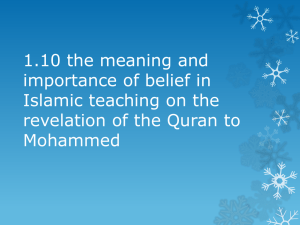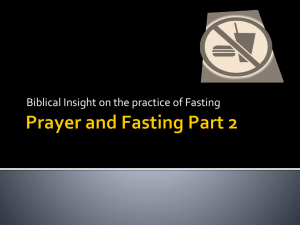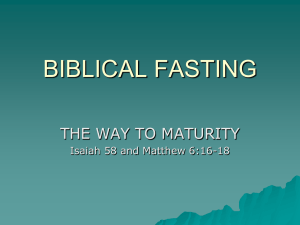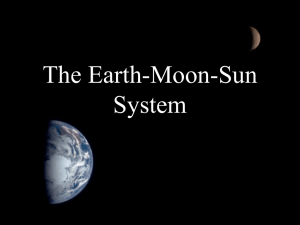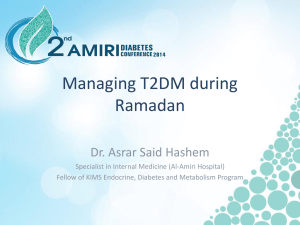Ahkam-us-Siyam: The Rules of Fasting
advertisement
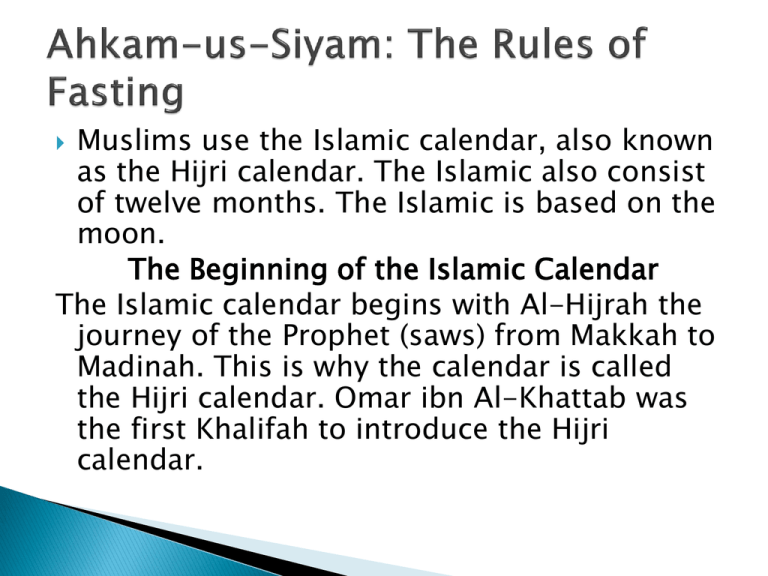
Muslims use the Islamic calendar, also known as the Hijri calendar. The Islamic also consist of twelve months. The Islamic is based on the moon. The Beginning of the Islamic Calendar The Islamic calendar begins with Al-Hijrah the journey of the Prophet (saws) from Makkah to Madinah. This is why the calendar is called the Hijri calendar. Omar ibn Al-Khattab was the first Khalifah to introduce the Hijri calendar. The lunar month starts when the moon appears in crescent shape. This is called the “new moon”. Slowly, the crescent shape becomes thicker and thicker. A full moon occurs in the middle of the month. Then the full moon starts to go back to its crescent shape and gets thinner and thinner, until it disappears. That is the end of the lunar month. The moon revolves around Earth. This is what causes the changes in the moon’s shape. One lunar month is either 29 or 30 days. Gregorian calendar follows the pattern of the sun, Gregorian months usually have 30 or 31 days. Therefore, there the Lunar year is 354 days while the Solar year is usually 365 days long. ً ض َيا ًء َو ْال َق َم َر ُن از َل لِ َتعْ لَمُوا َع َد َد ِ س َ ْه َُو الَّ ِذي َج َع َل ال َّشم َِٰ ورا َو َق َّد َرهُ َم َن َّ اب ۚ َما َخلَ َق ِّ ُي َف ۚ ك إِ َّّل ِِ ْال َح ِّق ِ ص ُل ْاْل َيا َ َِّللا ُ َذل َ ين َو ْال ِح َس َ ت لِ َق ْو ٍم ال ِّس ِن ُون َ َيعْ لَم It is He Who made the sun a shining thing and the moon as a light and measured out for it stages, that you might know the number of years and the reckoning. Allâh did not create this but in truth. He explains the Ayât (proofs, evidences, verses, lessons, signs, revelations, etc.) in detail for people who have knowledge. : قال رسول َّللا صلى َّللا عليه وسلم: عن اِن عمر رضي َّللا عنه “”الشهر تسعة أو ثالثون Ibn Omar reported that Rasoolullah (saws) said “A month is twenty nine or thirty days.” َّللا ِ َّللا ْاث َنا َع َش َر َشه ًْرا فِي ِك َتا ِ َّ ب ِ َّ ُور ِع ْن َد ِ إِنَّ ِع َّد َة ال ُّشه “The count of month (in the year) for Allah are twelve in the book of Allah.” There are 12 months in the Islamic year, just like in the Gregorian year. The following table lists all the Islamic month in the lunar year. Month( English) 1 محرمMuharram 2 صفرSafar 3 رِيع اّلولRabee’-ulAwwal 4 رِيع الثانيRabee’-uthThani 5 جمادى اّلولJumadal-awwal 6 جمادى الثانيJumad-Thani 7 رجبRajab 8 شعِانShab’ban Main Events Ashuraa The birth of the Prophet Mohammad(saw s) The death of the Prophet Mohammad(saw s) Isra’ and Mi’raaj 10 شوالShawwal 11 ذوالقعدةDhul-Qi’dah 12 ذوالحجةDhul-Hijjah Hajj Eid-ul-Adha Every year the beginning of Ramadan brings new challenges to the Muslim community. Should Ramadan begin with the sighting of the moon locally? Do we rely on the calculations of the new moon by an observatory? These and many other questions are often asked at the beginning of Ramadan. This problem is because many Muslims do not understand the fine details that go into the beginning of Ramadan according to the books of Islamic Fiqh. The month of fasting starts with the beginning of he lunar month of Ramadan. This event is confirmed traditionally by sighting the new crescent moon by the sunset of the 29th day of the lunar month of Sha’ban. If the crescent moon is not seen, Muslims wait until the thirty days of Shaba’ban are completed, then they start fasting of Ramadan. Abu Hurayrah reported that the Prophet instructed: “Fast after you have seen it (the new crescent) and end the fast (at the end of the month) when you see it. If it is hidden from you, then wait until the thirty days of Sha’ban have passed. According to the majority of imams, the report on only one pious person is accepted to decide the beginning of Ramadan. Ibn Umar said: “ The Prophet were for the new moon and when I reported to the Messenger of Allah that I had seen it, he fasted and ordered the people to fast.” Concerning the new moon of Shawwal is confirmed by sighting the crescent moon by the sunset of the 29th day of Ramadan or by completing thirty days of Ramadan. Most fuqahaa, or jurist, state that the new moon Shawwal must have been reported by at least two pious witnesses. Many contemporary scolars started now to accept accurate astronomical information to determine the beginning and end of Ramadan and other lunar months. The use of astronomical data is now acceptable to many contemporary scholars, Islamic reigious organisations and countries. There are still many other scholars and antities who are still studying this issue are prefered to base their decision on the actual observaqtion of the cresent moon in the beginning and end of Ramadan. Sawm is the abstaining of food, drink, and sexual intercourse from dawn until sunset with the explicit intention of doing so for the sake of Allah. Fasting can be broken down into five separate types or categories. 1. Fard فرض: This is fasting done during the whole month of Ramadan once a year. 2. Wajib واجب: This refers to fasts that are made to : - fulfill a nathr, or a vow on a specific day or date for the sake of Allah, upon the fulfillment of someone,s wish or desire. - Make up for a day or more you missed fasting in Ramadan. - Fasting as a Kaffarah or expiation to expiate a religious mistake you made including ; including, but not limited to, an oath you broke, a killing by mistake, and other incidents. 3. Sunnah سنة: This refers to fast that are made according to the noble example of Rasoolullah like fasting ‘Ashouraa’ on 10th of Muharram or the Day of ‘Arafah on the 9th of thul Hijjah. 4. Mustahabb مستحب: This refers to all fasts that are encouraged outside the ob;igatory fasts such as fasting on Mondays and thursdays, and 13th, 14th and 15th days of every month. 5. Haram حرام: Such as fast on the first days of Eid ul Fitr, Eid ul Adhaa, and the days of Tashreeq during Hajj (11th, 12th and 13th days of Thul-Hijjah) for the pilgrims. 1. Niyyah: The Intention to fast The sincere intention to fast is a necessary act of fasting. Sincere intention allows you to put away the troubles of the world and concentrate solely on fulfilling Allah orders. It is not necessary to express the intentions verbally, because sincere intention is placed in the heart. However it is permissible to express intention verbally also. Intention should made the night before each day that tomorrow I will fast. The voluntary fasts can be intended up until the time of the early morning until noon. Fast starts from dawn and ends at sunset every day. A Muslim stops eating slightly before Fajr and breaks the fasting immediately at sunset. Du’aa for breaking the fast ”الهم لك صمت وعلى رزقك أفطرت ذهب الظمأ واِتلت العروق وثِت “األجران شاء َّللا O Allah I fasted for you alone, and broke my fast by eating what you have given me. Thirst is over, my flesh is watered, and my reward for fasting is approved by the will of Allah. - Sohoor: سحورSohoor is a pre-dawn meal that takes place right before Fajr prayer. It is of the Prophet(saws) Delaying the Sohoor: It is also Sunnah of the Prophet to do so late as possible without eating after the Fajr adhan has been called. - Immediately breaking fast: It is Sunnah of the Prophet (saws) to break his fast immediately upon sunset. You shouldn’t delay breaking fast. This is a reward from Allah that we may eat immediately after the sunset. Breaking the fast with dates: Making intention during the night: Fasting the first six days of Shawwal It has been narrated that any six days during that month are recommended to fast. Abu Ayyuob al-Ansari reported that Rasoolullah said: He who observed the fast of Ramadan and then followed it with six (days) of Shawwal; it would be as if he fasted forever. Fasting on day of Arafah Abu Qatada al-Ansari reported that Rasoolullah(saws) was asked about fasting on the day of Arafah whereupon he said: It expiates the sins of the preceding year and the coming year. In a Hadeeth related by Ibn Abbas (R) when the Messenger of Allah came to Madina, He found the Jews fasting the day of Ashuraa. He inquired why they did so. They replied that it was a good day, the in which Allah delivered the Prophet Musa and the children of Israel from their enemy, Pharaoh. As Musa fasted that day. The Prophet responded: I am closer to Musa than you. He, then fasted the day and commanded the believers to fast. The Prophet was asked about fasting on the day of Ashuraa , whereupon he said: it expiates the sin of the preceding year. Abu Qtqda Ansari (RA) reported that Allah’s Messenger (saws) was asked about fasting on Monday, whereupon he said: it is (the day) when I was born and revelation was sent down to me. Osamah ibn Zayd narrated the Prophet (saws) used to fast on Monday and Thursday. Narrated by Hafsah Ummul Mu’minin : The Prophet of Allah(saws) used to fast three days every month: Monday, Thursday and Monday in the next week. 1. What are the similarities and differences between Lunar and Solar years? 2. Compare and contrast Islamic and Christian fasting. 3. Define: a. Suhoor b. Imsaak, Niyyah c. Aashouraa 4. What is the Lunar year made of? Support your answer with an Ayah. 5. How many days in the Lunar month? Support your answer with a Hadeeth. 6. What are the types of Siyam? 7. What are the mandatory actions of Siyam? 8. How a Muslim observes the Niyyah of fasting? 9. What should a fasting Muslim abstain from? 10. What are some of the optional fasting outside Ramadan?

